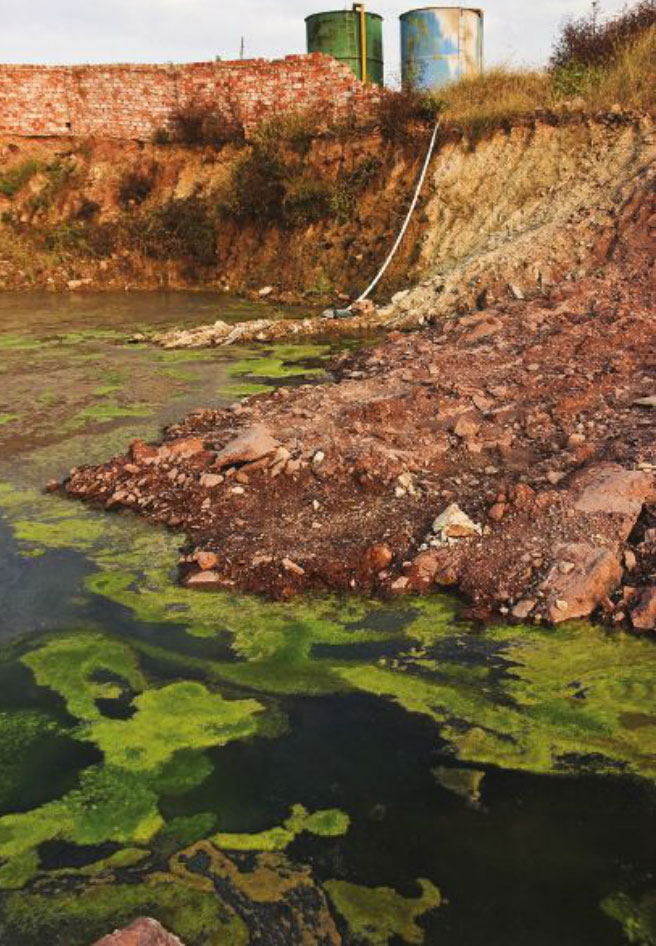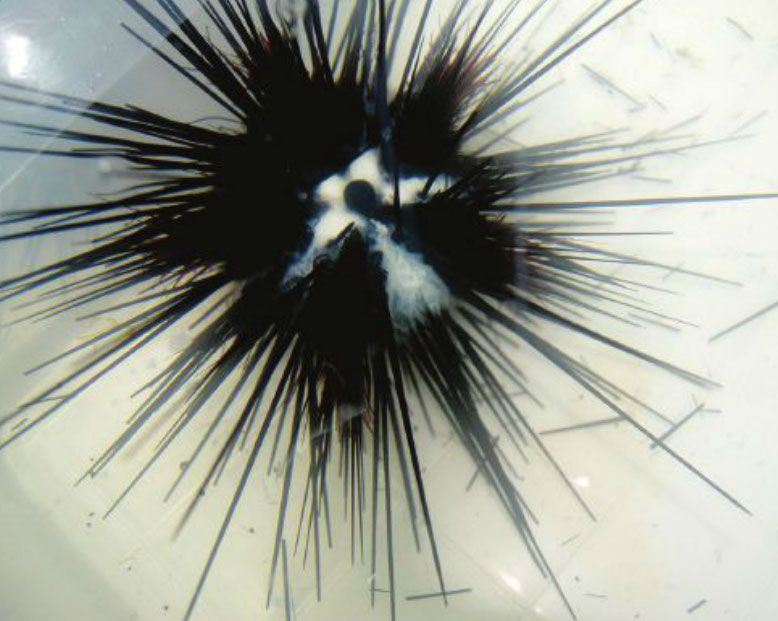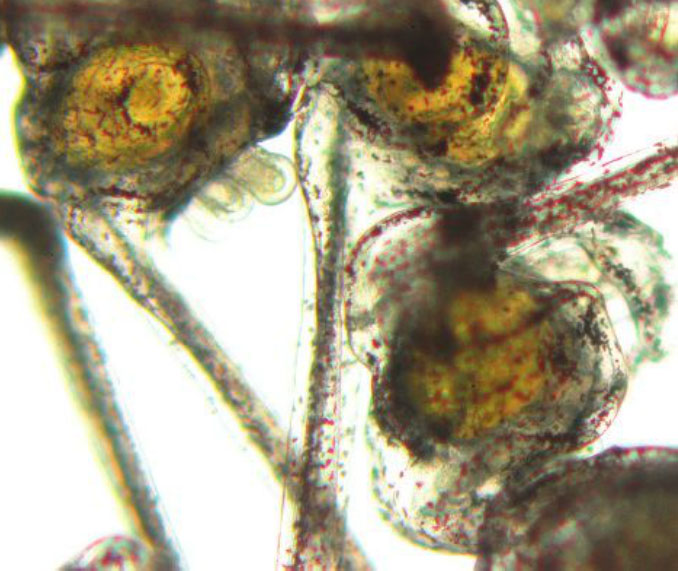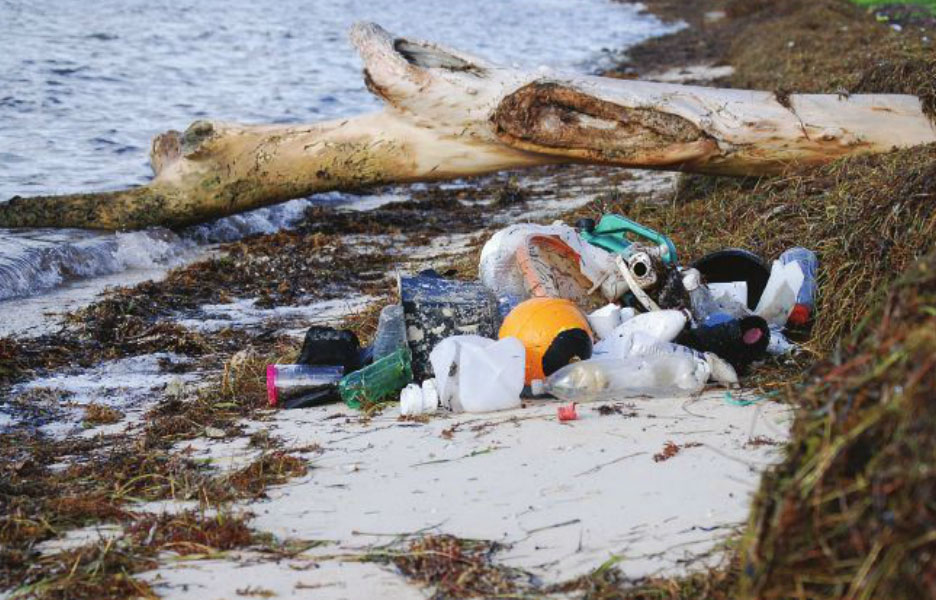
Blue waters and blue skies near Miami, Florida, belie the presence of endocrine disruptors from coastal development and everyday human use of drugs and household chemicals. Image by Worachat Sodsri / Shutterstock
By Martin Moe; Images by Martin Moe unless otherwise noted – An excerpt from the January/February 2012 issue of CORAL Magazine
Mother Earth went to the doctor for her 50,000-year checkup. The doctor sat her down in his office afterward and said, “Well, I have some bad news. You have an unnatural cancer in all your oceans and waters. I know you feel good now, at least reasonably good, considering everything, but if we don’t take care of this very soon you will become crippled and much of the life you have created may even disappear. Your cancer is the unchecked accumulation of endocrine disruptors.”
“Oh, my God, Doc, I bet that’s the cause of the nausea I feel in my plankton,” responded Mother Earth. “Most likely so,” said the doctor. “This is a root-of-life problem, and its effects are spreading up your food chains. Unless we get this under control soon, there is the real possibility that your ecosystems will change drastically, and your intelligent life, unique in your solar system, will decline and regress into famines and wars.” Mother Earth got up to leave and said, “I’ll do my best, Doc, but those dumb humans had better get their act together. What they have done to me in the last 100 years is criminal, even if they didn’t know what they were doing.”
We can see and smell what we know is pollution and the results of pollution, including oil, sludge, black water, hydrogen sulfide, plastic and other debris, dead fish, sick birds, algae blooms, and trash on our beaches and reefs. But there is a great load of chemicals, natural and manmade, created by our advanced civilization that have been accumulating in our environment, most in extremely small concentrations, for many years. These invisible chemicals are dissolved in water in very low concentrations and escape our notice—and usually our concern. Some are considered harmless, some beneficial (especially the natural ones), but many of them are suspected or known to be endocrine disruptors.
WHAT ARE ENDOCRINE DISRUPTORS?
Endocrine disruptors are substances that can interact with all the normal biological processes of life that depend on hormone activity. However, those that affect the hormone receptor systems during reproduction and development are particularly insidious because even in very low concentrations, they can have profound and deleterious effects on early development. These effects include corrupted development and function of reproductive organs and disruption of development and mortality of egg and larval stages, and this can have deadly effects on populations of aquatic vertebrates and invertebrates. Some endocrine disruptors affect reproduction and development in male systems, some in female systems, and some in both. Many endocrine disruptors are resistant to environmental degradation, thus they gradually accumulate and are present in various forms and concentrations over almost all aquatic ecosystems.
It is an absolute certainty that endocrine disruptors are present in Florida Bay, our canals, and the nearshore waters of the Florida Keys, as well as in all other aquatic ecosystems of our planet. What is not known is what chemicals are present, in what concentrations, and at what times—and most important, what effects, if any, these chemicals have on the presence and development of aquatic life in our waters.
We routinely measure and base our definitions of water quality on things such as temperature, salinity, turbidity, bacteria, chlorophyll, and nutrients that are present at fairly high levels, parts per thousand, or parts per million. These elements are very important indicators of water quality, but they are only the tip of a huge iceberg. The effluent of modern civilization includes many natural and synthetic compounds with long chemical names. They come from a great many sources: hormones and hormone derivatives from human populations, household chemicals, waste pharmaceuticals, and most anything that finds its way into waste water— land runoff with all its fertilizers, herbicides, pesticides, oil residues, plastics, pet feces, and construction waste. Also included is the chemical breakdown of discarded plastics, waste and chemicals from marine industries, crude oils from spills, and the aquatic disposal of industrial waste in rivers as near as Florida and as far away as the Mississippi and even the Amazon. Contributions from the atmosphere are also present—airborne pollutants from our own industrial and electric plants, as well as hurricane and tradewind dust from toxic wastelands in Africa.
Many of these chemicals are subject to bio-concentration and bio-accumulation in the food chain, passing from algae and plankton into larger and larger organisms. The science and chemistry of endocrine disruptors is a relatively new and rapidly expanding field of study. The theory that environmental chemicals could be disrupting hormone activity in aquatic and terrestrial animals was first published in 1992. The effects of miniscule concentrations of these chemicals are as farranging as the longest tendril of human civilization, and the science is as complex as the biology of life.
Endocrine disruptors and their effect on marine life should be a topic of intense research, but this is not yet the case. For example, a very comprehensive 2007 technical report entitled “Florida Bay Science Program: A Synthesis of Research on Florida Bay,” edited by J. Hunt and W. Nuttle (Fish and Wildlife Research Institute Technical Report TR-11, pp. i–148), extensively discusses nutrient dynamics and water quality as related to nutrients and briefly discusses mercury and pesticide pollution. The work of Dr. G. I. Scott on the presence of the organochlorine insecticide endosulfan from runoff into Florida Bay is cited. But the paper does not mention the probable presence and destructive potential of endocrine disruptors.
Unlike the straightforward toxicity of herbicides and pesticides, the effects of endocrine disruptors are present at very low concentrations, and additionally, they are most active at critical stages of the life cycle such as reproduction, molting, embryonic development, and metamorphosis. These life stages occur in most marine organisms (embryonic, larval, and metamorphic) and take place in the plankton. Thus for all intents and purposes, they are invisible to most research methods. A failure of fertilization at the time of spawning or the mass mortality of a larval or post-larval stage would typically pass unnoticed. The composition and abundance of plankton—copepod populations, for example—is at the base of the food chain. A disruption in survival of planktonic organisms reverberates upward into the populations of our most valuable commercial and recreational species. Unfortunately, analysis to determine the presence and concentration of these chemicals, especially in concentrations of only parts per billion or trillion, is not an easy or inexpensive task, thus it is seldom undertaken. Perhaps even more daunting is the research effort necessary to determine the effects that such chemicals might have on various marine organisms. The only evidence of the possibility of such a problem is abnormal development, reproductive failure, absence of a year class, or obvious declines in populations.

Coastal pollutants and runoff have been recognized as major causes of reef damage, but we are now realizing that coral and fish larvae cannot survive in a soup of modern chemicals. Image by Dominique Landau / Shutterstock
PLASTIC TRASH: NOT SO INERT
One of the greatest sources of endocrine disrupting chemicals is the disintegration of plastic waste in the marine environment. No beach, no reef, no bay, no lagoon is without plastic waste of some type and there are vast “garbage zones” of plastic waste in ocean gyres of the Pacific and Atlantic Oceans. Reportedly, there are 6 pounds of plastic for every pound of plankton in the “garbage gyre” of the Pacific.
Environmental pollution from plastics and plastic decomposition consists of bisphenols, alkylphenols, and phthalates, which find their way into waters and aquatic life throughout the world. Herbicides, pesticides, and derivatives of their decomposition (endosulfan, chlorthalonil, chlorpyrifos, alpha-chlordane, gammachlordane, t-nonachlor, alpha-HCH, gamma-HCH, and trifluralin) were measured in high frequency in Florida Bay at concentrations that would not be acutely toxic but could produce endocrine disruptors.
PCBs, fire retardants, and wood preservatives are also present. Land runoff is a major source of these chemicals, and septic tanks and inadequately treated sewage also release natural hormones, pharmaceuticals, and household chemicals, as well as nutrients, into the near-shore environment. Chemical compounds with heavy metals such as mercury, cadmium, lead, tin, copper, silver, selenium, nickel, and zinc are widely used in marine industries and boating and are present in industrial and household waste. Various compounds of these metals have been shown to have toxic and endocrine disruptive effects.
The effects of plastic pollutants such as BPA (bisphenol A) on the development of human children, especially females, are a matter of great concern and extensive research. Most studies on endocrine disruptive effects are done on vertebrates, and it is speculative to extend those results to marine invertebrates. But hormone activity is also at the root of life for invertebrates, and it is not a stretch to think that known endocrine disruptors in vertebrates would also have the potential to affect reproduction and development of the microscopic larvae of aquatic invertebrates. Invertebrates make up 95 percent of all the species of animals on earth and are at the base of most marine food chains. Even though we are making progress, we still know comparatively very little about the potential effects of endocrine disruptors on invertebrate populations. In my little corner of the world, Florida Bay is a large and shallow body of water with input from the Everglades, all the rivers of the Gulf of Mexico, especially the Florida Gulf Coast, and the flow from the Caribbean Sea. Florida Bay has numerous islands and shallow banks that restrict circulation and limit flushing currents. Evaporation increases salinity and concentrates nutrients and chemical pollutants, including endocrine disruptors. The bay is considered a sink (collector) for nutrient inputs (phosphorus and nitrogen), and presumably other dissolved chemical compounds as well. And the numerous deep canals, constructed during the development of the Keys, collect organic muds and sediments that contain chemical contaminants and slowly release them to the near-shore waters through tides and diffusion through porous coral rock.
“SMOKING GUNS”
So if the presence and biological effects of endocrine disruptors are so difficult to determine, measure, and observe, how do we know if there is a problem? What are the actual effects, and can we do anything about it? Despite the “stealth attack” that endocrine disruptors present and the paucity of definitive scientific confirmation of their activity in Florida Bay, there are indications that they are present and active. In a study reported in 1974, high levels of DDT, arsenic, and methylmercury were found in the tissues of fish, invertebrates, and birds. The work of Dr. G. I. Scott and colleagues, published in 2002, investigating the high-toxicity agricultural pesticide endosulfan in the C111 canal and bay waters, detected endosulfan in 100 percent of the samples. Results such as these do not prove that endocrine disruptors from agricultural and industrial chemicals are causing mass mortalities or even that they diminish survival of larval fish and invertebrates in Florida Bay—only that such chemicals are widespread in this environment. But there are a few “smoking guns” that do seem to provide that indication.
In the 1990s, Robert Glazer and Gabriel Delgado, marine scientists with the Florida Wildlife Research Institute laboratory in Marathon, Florida, encountered problems while working with the culture of Queen Conch at the Long Key Marine Laboratory. Compared to culture work at other hatcheries in the Caribbean, the larvae of Queen Conch took twice as long to develop to settlement and the densities of larvae in the culture had to be reduced by 20 times. The water taken from the bay side of Long Key had to be treated with ozone and activated carbon in order to achieve good survival. Experimentation showed that there were chronic effects on conch embryos, including development of abnormal cells after exposure to two mosquito control pesticides, permethrin and naled, at concentrations typical after spraying. At the same time, it was discovered that adult Queen Conch in near-shore waters of the Keys did not develop active gonads and reproduce, although historically, populations in these areas did successfully spawn. Adults in offshore areas spawned normally. Most interesting, the gonads of adults in offshore areas that were moved to near-shore areas regressed and the conch stopped spawning. Conversely, the gonads in adults from nearshore areas that were moved to offshore areas developed to functionality in as little as 3 months, and these relocated adults began spawning. Bob Glazer reports that endocrine disruptive activity on Queen Conch in the near-shore waters of the Keys is strongly anti-estrogenic (female) and mildly anti-androgenic (male). Additional studies exposing adults to heavy metals, pharmaceuticals, and industrial and agricultural chemicals and near-shore water temperatures were conducted. The conclusions were that zinc and copper compounds could be partially responsible for the lack of spawning in near-shore adult conch.

Male Diadema antillarum sea urchin releasing sperm in Moe’s lab, where in the past he has successfully spawned and reared the species through metamorphosis.
URCHINS AS BIOINDICATORS
My work with the culture of the Long-Spined Sea Urchin, Diadema antillarum, the keystone herbivore of the western Atlantic coral reefs, also produced results indicative of the presence of endocrine disruptors. My small laboratory is located on the bay side of Lower Matecumbe Key, only a few miles from the FWRI marine laboratory on Long Key. Diadema have long-lived, pelagic larvae. The larval stage is typically at least 35 to 40 days and may extend to several months. They have a complex metamorphosis. The juvenile (termed the rudiment) grows within the body of the larva, and when the larva is about 500–600 microns in length the rudiment extends one or more tube feet that are capable of attachment to a substrate. At the time of attachment metamorphosis begins, the rudiment expands, larval tissues regress into the rudiment, and the early juvenile is formed. Although some of my larvae successfully metamorphosed into juveniles that survived, most either could not complete metamorphosis or could never begin metamorphosis, or died shortly after becoming early juveniles. Despite many experimental efforts and correction of a number of problems, some factor, perhaps the presence of endocrine disrupting chemicals, apparently prevented normal hormonal activity at the time when it is most critical to successful metamorphosis. Hopefully, I will be able to experiment further with correcting the causative factors, presumably water quality, at some future time.

Sea urchin larvae at day 29: the author became suspicious when some hatches of larvae failed to complete metamorphosis. Experts believe endocrine disruptors could be the culprit.
Direct toxicity may also be a factor. Because of their sensitivity to toxins, sea urchin larvae, juveniles, and adults have long been used as indicator organisms in marine science to determine the toxicity of various elements and compounds. A study from the University of Miami in 2005 investigated the sensitivity of Diadema antillarum to the metals copper, silver, nickel, and selenium. Levels of all these elements in the ranges of 2–8 parts per billion (ppb) caused abnormal development in the larval stages, and at the highest levels tested (73–126 ppb) embryonic development did not progress past the very early stages. So far, D. antillarum is the tested marine species most sensitive to nickel and selenium and the second most sensitive to silver and copper. Selenium is commonly used in glassware, various chemicals, and pigments. Copper ions are water soluble and copper compounds have many uses, such as in boat bottom paint, wood preservatives, and fungicides that bring them into contact with the marine environment. Metal concentrations in seawater typically range from about 0.1 ppb to about 10 ppb, and up to about 130 ppb in waters with known pollution issues. These metals in one chemical form or another are undoubtedly present in Florida Bay and also in the near-shore waters of the Keys. At what concentrations, at what places, and at what times, however, is not well known.
Before the 1983 plague, Diadema antillarum urchins were very common, not only on the offshore coral reefs but also on hard bottoms and rock structures throughout the near-shore waters of the Florida Keys. They can now be found in very low densities, widely scattered in the offshore waters of the Keys, but are very rarely found anywhere in the inshore waters of the Upper Keys, where they once were very common. Since they settle and survive on the offshore patch and barrier reefs, the pelagic larvae are most certainly also present in the inshore waters. Other species of sea urchins are present in these waters. However, in the last 10 years, I can recall seeing only two Diadema in the near-shore waters off Lower Matecumbe Key. This could be due to the great scarcity of larvae in these waters and the lack of suitable settlement substrate; but it may also be a result of the presence of endocrine disruptors in the near-shore waters, preventing normal development at the time of metamorphosis.
In 2008, Dr. Gregory Beck and colleagues conducted a study on the immune system of Diadema antillarum and other tropical Atlantic sea urchins and found that Diadema have a weakened immune response compared to other urchins, and this may have been instrumental in their susceptibility to the pathogen that caused mass mortality in this species throughout the tropical western Atlantic in 1983. It may also indicate that this species is more susceptible to the effects of endocrine disruptors than other species of sea urchins. Some endocrine disruptors and/or toxic chemicals found to affect embryogenesis, development, and sexual development in echinoderms are cadmium, zinc, estradiol, estrone, PCBs, and PCP. Thus, despite the difficulty of culture, Diadema may be a valuable indicator organism for the presence of endocrine disruptors, and, due to its sensitivity to metals, it may be an indicator species for metal pollution as well.
THE INTERSEX FISH PHENOMENON
Most research into the effects of endocrine disruptors has been done on vertebrates. The effect of DDT and its derivative, DDE, on wild bird reproduction is most well known. And more recently, abnormalities in the reproductive systems of alligators and great declines in alligator populations in Lake Apopka, Florida, have been widely reported. Levels of DDE in alligator eggs from Lake Apopka were higher than those that were known to harm eagles.
The concentration of endocrine disruptors in fresh water is much greater than it is in marine waters. Most bodies of fresh water are closer to pollution release points and have higher concentrations of waste chemicals, where they occur, than brackish and marine environments. The most obvious effects of endocrine disruptors in rivers and lakes are high incidences of fish with abnormal sexual development and a loss of reproductive capability in these populations. Normal sexual development in many marine fish consists of various forms of hermaphroditism, a change from female to male, such as in groupers, and male to female, such as in clownfish, but most marine and freshwater fish are gonochoristic, meaning that there is no normal change of sex or functional intersexuality. So when male and female intersex fish occur in populations of freshwater fish it is a cause for great concern, and this has been happening in rivers and lakes throughout the world. A recent article in Nature (15 August 2011) reports on incidences of pharmaceutical pollution in the United States, India, and France that have been directly linked to disruption of sexual development in populations of wild fish.
In the United States the problem of intersex freshwater fish, primarily small- and largemouth bass and now channel catfish, is becoming a great problem. In the southeastern United States the percentage of intersex largemouth bass in various populations has ranged from 8 to 91 percent. The Pee Dee River at Bucksport, South Carolina, contained the highest percentage of intersex fish (91 percent). In other areas, 60 percent of male bass examined at the Apalachicola River at Blountstown, Florida, were intersex, as were 50 percent in the Savannah River at Port Wentworth and Sylvania, Georgia, 43 percent in the Savannah River at Augusta, Georgia, and 30 percent in the Chattahoochee River at Omaha, Georgia and the Flint River at Albany, Georgia. A lower percentage of intersex (10–25 percent) was found in bass from sites in the Mobile River in Alabama.
The big question, of course, is how does the development of intersex fish affect spawning success? In a March 2011 paper in Environmental Health Perspectives, Catherine Harris and colleagues reported on experiments at the UK Environmental Agency with wild roach (Rutilus rutilus) from effluent- contaminated rivers. They found that although intersex fish were able to breed with various levels of success, reproductive success was reduced by 76 percent for the most severely feminized fish, demonstrating a significant adverse reproductive effect of the intersex condition. It could be argued that it is only a matter of time before the effects of endocrine disruptors are found in populations of marine fish in inshore marine and brackish waters as well, and of course that would mean that marine invertebrates would probably also be affected.
In a 2011 publication, Piero Gardinali discusses the input of some common polluting microconstituents from personal care products and pharmaceuticals that are found in waste water and urban runoff. These include insect repellents, sunscreens, fragrances, plasticizers, human and veterinary pharmaceuticals, anti-inflammatory drugs, antibiotics, birth control hormones, and many other drugs. Endocrine disruptors in this witch’s brew include Beta-Estradiol and Estrone, components of human estrogen hormones, and Bisphenol-A, a plasticizer, among others. Many microconstituent endocrine disruptors can survive existing waste water treatments and move through underground waters into freshwater and marine environments.
These and other endocrine disrupting chemicals can affect aquatic life in concentrations as low as parts per billion and parts per trillion. Add this to the realization that we know very little about if and how they affect the marine environment— and, to use the vernacular, it’s, like, very, very, scary!
What can we do to reduce the incidence of unnatural endocrine disruptors in our marine environment? The simple answer has two parts: 1) stop the addition of endocrine disrupting chemicals into the marine environment, and 2) clean up what is already in the environment. Of course, it is not that simple. Both arms of such a project will require a great deal of funding and research. Such funding is not easy to obtain, given the economic imperative to produce products as cheaply as possible and to avoid cleaning up the mess they might cause. The current economic crisis and the emphasis on creating jobs, increasing production, and stimulating the economy is also not very compatible with current and new initiatives to conserve and restore our marine environment. Short-term economic considerations always seems to trump long-term protection of resources.
What we really need is to grow up. When young children spill their milk we admonish them to be more careful and then we clean it up. When teenagers spill their milk we scream and holler at them and make them clean up their own mess. Hopefully humanity is now out of the little child stage and almost past the unruly and dangerous teenage stage.

Plastic trash collected by the author from a small area on Sea Oats Beach close to his home, near Islamorada, Florida Keys.
It is time for us all to become aware of the environmental disaster that shadows our future, and scream and holler at those who are causing the biologically active pollution that surrounds us and threatens to destroy our marine resources. We all must do our share to get educated and to clean up our act—but the industries that are creating the problems must also be held accountable for the environmental disasters that are the potential results of their products, just as we are also responsible for using them. We can ignore the problem or just poke at it a little, but that would only be passing it on to a future generation, and by then it might be too late. The accumulation of biologically active chemicals in our environment will only increase, the rate of this increase will only accelerate, and the deleterious effects on the environment will not abate unless we figure out a way to combat this silent but significant problem.
A great many jobs can be created by committing to a greatly needed, serious program of scientific research to include determination of what is affected, how it is affected, and by what, and cleaning up existing plastic pollution—developing ways to recycle what can be recycled and preventing the rest from entering the environment. These projects should be funded in great part by the industries that contribute to this problem. Standardized methodologies for assessment of the presence and activity of endocrine disruptors have been, and are being, developed. Marine aquaculture of fish and invertebrates is a rapidly expanding industry with such a strong economic potential that grants and subsidies for research and development are readily available. Research on the presence and effects of microconstituent endocrine disruptors as part and parcel of aquaculture research could benefit both commercial and environmental interests. I think a worldwide program of research and action, patterned on the intensity and necessity of the Manhattan Project, is required now to prevent environmental disaster in the not-too-distant future.

The author with sea urchin broodstock in his home breeding lab on Lower Matecumbe Key, Florida. – Image By Matthew L. Wittenrich / Aquatic Pixels
About The Author
Martin Moe is a marine biologist who lives on Lower Matecumbe Key, Florida, directly on the Gulf of Mexico. He is the author of The Marine Aquarium Handbook: Beginner to Breeder (Microcosm/TFH, 2009).
References
Gilbert, N. 2011. Drug waste harms fish. Nature 476, 265 (2011). Online at http://www.nature.com/news/2011/150811/ full/476265a.html
Harris, C.A. et al. 2011 The Consequences of Feminization in Breeding Groups of Wild Fish. Env Health Persp 119 (3), March 2011. Online at http://ehp03.niehs.nih.gov/article/fetchArticle. action?articleURI=info%3Adoi%2F10.1289%2Fehp.1002555
On The Internet
Fish and Wildlife Research Institute Technical Report TR-11: http://research.myfwc.com/publications/publication_info. asp?id=52697
Manire, C., E. Cortes, and L.E.L. Rasmussen. The Mechanisms and Effects of Endocrine Disruption on Infertility in the Bonnethead Shark on Florida’s Gulf Coast. http://www.epa. gov/ncer/science/endocrine/pdf/wildlife/r826128_manire- 030105-final.pdf
This article was originally published in CORAL Magazine, January / February 2012. Don’t miss out on content you’ll find nowhere else – subscribe today!






Trackbacks/Pingbacks